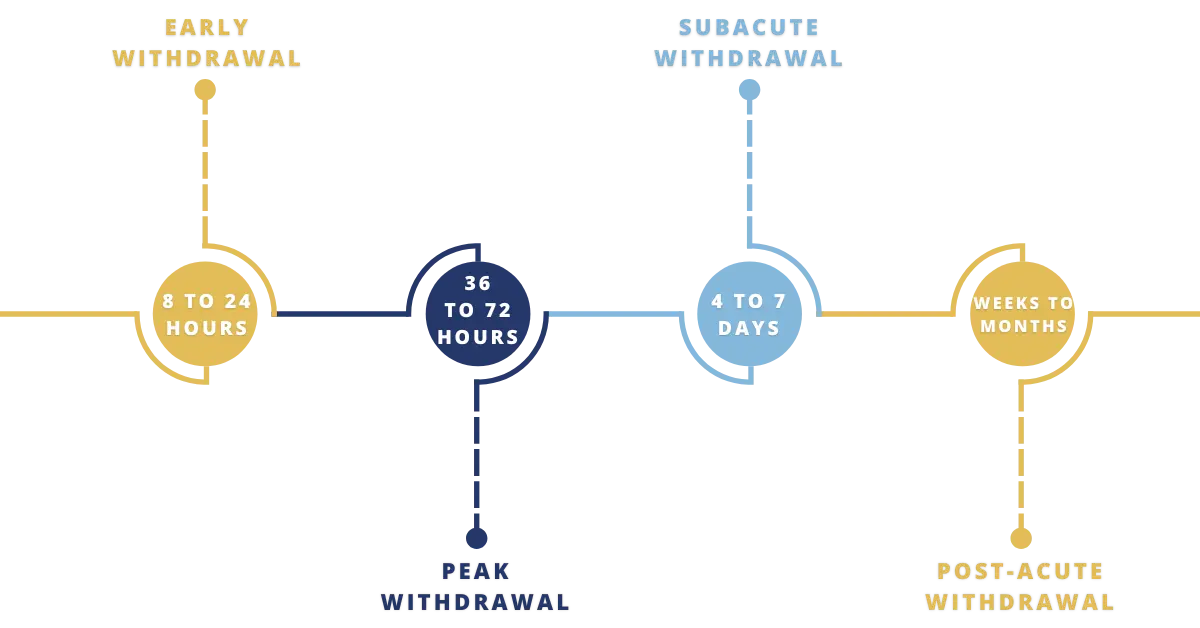Fentanyl Withdrawal Timeline, Symptoms, & Treatment
Fentanyl withdrawal is a challenging and often intense process that occurs when individuals abruptly stop or significantly reduce their use of fentanyl. As a highly addictive substance, fentanyl can lead to physical and psychological dependence, making the withdrawal experience distressing for those attempting to quit. This is why it’s essential to recognize and understand the fentanyl withdrawal timeline, symptoms, and treatment to ensure that individuals can properly navigate the withdrawal process and achieve long-term recovery from fentanyl addiction.
In this article, we will discuss what fentanyl is, the side effects of fentanyl use, the fentanyl withdrawal timeline and symptoms, and how to treat fentanyl addiction.
What is Fentanyl?
Fentanyl is a powerful synthetic opioid drug primarily used for its pain-relieving properties. It belongs to the class of medications known as analgesics, which are commonly prescribed to manage severe pain. Fentanyl is one of the most potent opioids available for medical use, and it is estimated to be up to 100 times stronger than morphine and about 50 times stronger than heroin. There are currently two types of fentanyl available: pharmaceutical fentanyl and illegally made fentanyl.
According to the Centers for Disease Control and Prevention (CDC), fentanyl is one of the most common drugs involved in overdoses, with over 150 people dying daily from opioid overdose. This is due to the abundance of illegally made fentanyl that is available on the street drug market and is commonly mixed with other illegal substances such as cocaine, heroin, and methamphetamine. This can be extremely dangerous as many individuals will not be aware that their drug of choice has been laced with fentanyl, leading to overdoses.
Read More: Can You Survive a Fentanyl Overdose?

Side Effects of Fentanyl Use
Fentanyl use can lead to a range of side effects, which can vary depending on the dosage, method of use, individual tolerance, and overall health of the individual using the drug. Many of these side effects can cause negative health consequences, some being life-threatening. Some of the most common side effects include:
- Nausea or vomiting
- Respiratory depression
- Extreme drowsiness
- Impaired cognitive function
- Skin rashes or itching
- Intense euphoria
- Confusion
- Loss of consciousness
- Coma
Signs You Are Addicted to Fentanyl
Like heroin, morphine, and other opioids, fentanyl attaches to the opioid receptors in the brain that regulate pain and emotions. Over time, repeated use of opioids causes the brain to adjust, reducing responsiveness and making it difficult for individuals to experience pleasure from anything other than the drug. As addiction takes hold, the pursuit and use of the drug become the central focus of a person’s life. Some common signs that may indicate an individual is addicted to fentanyl include the following:
- Intense cravings or urges
- Increased tolerance
- Isolating from friends or family
- Neglecting personal hygiene or responsibilities
- No longer enjoying previous activities
- Experiencing mental health conditions such as anxiety or depression
- Going through withdrawal symptoms

What Does Fentanyl Withdrawal Look Like?
Fentanyl withdrawal is highly uncomfortable, and while not generally life-threatening, the severity of the withdrawal can depend on a variety of factors. This can include the dosage, underlying medical conditions, and the length of use. While fentanyl withdrawal can look different for everyone, there are some common fentanyl withdrawal symptoms to be aware of.
Fentanyl withdrawal symptoms can be distressing and challenging to endure, often driving individuals to continue using the drug to alleviate the discomfort. These symptoms can be grouped into two distinctions: physical and psychological symptoms.
Some of the most common physical withdrawal symptoms include:
- Muscle pain
- Nausea or vomiting
- Sweating
- Watery eyes
- Heightened pain sensations
- Blurred vision
- Insomnia
- Changes in appetite and weight fluctuations
Some of the most common psychological withdrawal symptoms include:
- Irritability
- Mood swings
- Depression
- Restlessness
- Anxiety
- Difficulty concentrating
- Fatigue or decreased energy levels
- Social withdrawal

Fentanyl Withdrawal Timeline
The timeline of fentanyl withdrawal refers to the progression and duration of withdrawal symptoms after discontinuing or significantly reducing fentanyl use and begins after the last use of fentanyl. While this timeline can look different for every individual, a general timeline of fentanyl withdrawal looks like this:
- Early Withdrawal (within 8 to 24 hours): Withdrawal symptoms typically begin within hours after the last dose of fentanyl. Early symptoms may include anxiety, restlessness, muscle aches, cravings, insomnia, sweating, and gastrointestinal issues.
- Peak Withdrawal (around 36 to 72 hours): Withdrawal symptoms usually peak within the first three days after the last dose. This period is often characterized by the most intense symptoms, including increased cravings, flu-like symptoms, nausea, vomiting, diarrhea, chills, and heightened anxiety.
- Subacute Withdrawal (4 to 7 days): After the peak phase, symptoms gradually subside, although some discomfort may persist. Symptoms during this phase may include lingering cravings, fatigue, mood swings, irritability, insomnia, and residual physical symptoms.
- Post-Acute Withdrawal (weeks to months): For some individuals, post-acute withdrawal syndrome (PAWS) may occur, which involves lingering symptoms that can last for weeks or even months. These symptoms can vary but often include mood swings, anxiety, depression, sleep disturbances, and intermittent cravings. PAWS can be challenging but tends to improve gradually over time.
Fentanyl Addiction Treatment
Treating fentanyl addiction requires a comprehensive approach that addresses the condition’s physical and psychological aspects. Successful treatment plans typically involve a combination of medical detox, behavioral therapies, medication-assisted treatment, and ongoing support. The treatment of fentanyl addiction typically occurs in an addiction treatment center to provide the necessary care and support under medical professionals’ supervision. The process for fentanyl addiction treatment involves:
- Medical Detoxification: Medical detox is the first step in treating fentanyl addiction. This process involves removing the substance from the body and managing withdrawal symptoms in a controlled environment. Fentanyl detox allows the individual to rid their body of the substance to begin their new life in recovery. Withdrawal management is essential at the beginning of recovery, as the symptoms that are mentioned above can be dangerous.
- Behavioral Therapies: Various behavioral therapies are effective in treating fentanyl addiction. Cognitive-behavioral therapy (CBT) helps individuals identify and change negative thought patterns and behaviors associated with drug use and opioid use disorder. Dialectical-behavioral therapy (DBT) can help individuals accept the reality of their lives and learn how to properly modify their behaviors. Other forms of therapy, such as music therapy, meditation, and equine therapy, are essential in providing various ways for individuals to heal.
- Medication-Assisted Treatment: Medication-assisted treatment is a common way to help individuals going through fentanyl detox, as medications can help alleviate withdrawal symptoms. These medications can also help keep cravings under control, maintain sobriety, and reduce the risk of overdose. Some of the medications used include methadone, buprenorphine, and naloxone.
- Aftercare Support: Continued support and care after initial treatment is crucial for life-long recovery. Aftercare support can involve continuing to go to therapy, attending support group meetings, and developing relapse prevention strategies.
Learn More: What’s the Deal with Kentucky’s New Narcan Vending Machines?

Addiction Treatment Services at Louisville Recovery Center
Experiencing fentanyl abuse and later fentanyl addiction can be challenging and distressing to many individuals. Once you have understood and recognized the signs of addiction, it is time to receive help for your addiction.
Louisville Recovery Center is here to provide innovative addiction treatment programs to those struggling with any substance abuse. Our experiential, holistic, and individualized treatment programs ensure that we address every aspect of addiction to provide the best care possible for our clients. With our inpatient, outpatient, dual diagnosis, family therapy, and experiential therapy treatment options, there is something here for anyone struggling.
If you or a loved one suffers from fentanyl addiction or substance use disorders, contact us today to learn more about treatment programs. Louisville Recovery Center aims to treat the entire person, not just the addiction. See how we can help you today!







